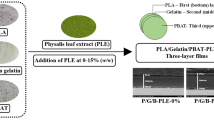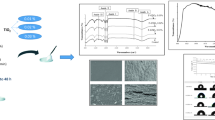Abstract
We investigated the functional properties of gelatin biofilms obtained from yellowfin tuna skin and developed an edible bioflim from fish byproducts to replace mammalian sources. For the biofilms, tensile strength and elongation were 48.57MPa and 15.2%, respectively. The color difference and yellow index values of the biofilms were higher than those of porcine films. The opacity of the biofilms was higher than that of porcine films. In water, the biofilms were stable at pH 4–7. Water vapor and oxygen permeability of the biofilms were 5.3 cm3/m2·day and 110 g/m2·day, respectively. The glass transition temperature and of the thermal stability of the biofilms was 56.30 °C and ∼260 °C, respectively.
Similar content being viewed by others
References
N. Cao, Y. Fu and J. He, Food Hysrocolloids, 21, 1153 (2007).
S.-J. Kim and Z. Ustunol, J. Agriculture and Food Chemistry, 49(9), 4388 (2001).
S. Y. Ou, K. C. Kwok and Y. J. Kang, J. Food Eng., 64(3), 301 (2004).
A. Jongjareonraka, S. Benjakula, W. Visessanguanb, T. Prodpranc and M. Tanakad, Food Hydrocolloids, 20, 492 (2006).
P.M. Gilsenan and S. B. Ross-Murphy, Food Hydrocolloids, 14, 191 (2000).
D. Achet and X.W. He, Polymer, 36(4), 787 (1995).
A. Bigi, B. Bracci, G. Cojazzi, S. Panzavolta and N. Roveri, Biomaterials, 19, 2335 (1998).
P. J. A. Sobral, F. C. Menegalli, M. D. Hubinger and M.A. Roques, Food Hydrocoll, 15, 423 (2001).
S. M. Cho, K. S. Kwak, D. C. Park, Y. S. Gu, C. I. Ji, D. H. Jang, Y. B. Lee and S. B. Kim, Food Hydrocolloids, 18(4), 573 (2004).
I. J. Haug, K. I. Draget and O. Smidsrød, Food Hydrocolloids, 18, 203 (2004).
R.A. Carvalho and C. R. F. Grosso, Food Hydrocolloids, 18, 717 (2004).
F. M. Vanina, P. J. A. Sobrala, F. C. Menegallib, R. A. Carvalhoa and A.M. Q. B. Habitante, Food Hydrocolloids, 19, 899 (2005).
M.C. Gómez-Guillén, J. Turnay, M. D. Fernández-Díaz, N. Ulmo, M.A. Lizaebe and P. Montero, Food Hydrocolloids, 16, 25 (2002).
J. H. Yoon, J.W. Woo, H. J. Rho, J.R. Ahn, S. J. Yu, Y.B. Lee, C.K. Moon and S. B. Kim, Korean J. Chem. Eng., 25(1), 134 (2008).
M. Gudmundsson, J. Food Sci., 67, 2172 (2006).
S. K. Kim, H.G. Byun and E. H. Lee, J. Korean Ind. Eng. Chem., 5, 547 (1994).
K. Osborne, M. N. Voight and D. E. Hall, Utilization of lumpfish carcasses for production of gelatin. Lancaster, PA, Technomic Publishing Co., 143 (1990).
B. Jamilah and K. G. Harvinder, Food Chemistry, 77, 81 (2002).
J. S. Kim, C.W. Ihm and P. H. Kim, Agricultural Chemistry and Biotechnology, 39, 274 (1996).
J. A. Arnesen and A. Gildberg, Bioresour. Technol., 82, 191 (2002).
J. H. Muyonga, C. G. B. Cole and K. G. Duodu, Food Chemistry, 87, 325 (2004).
B. Giménez, J. Turnay, M. A. Lizarbe, P. Montero and M. C. Gómez-Guillén, Food Hydrocolloids, 19, 941 (2005).
S. M. Cho, Y. S. Gu and S. B. Kim, Food Hydrocolloids, 19, 221 (2005).
J. H. Han and J.D. Floros, J. Plastic Film and Sheet, 13, 287 (1997).
B. H. Kim, J.W. Park and J. H. Hong, Korean J. Food Sci. Technol., 37, 30 (2005).
ASTM, Standard test methods for determination of oxygen gas transmission rate, permeability and permeance at controlled relative humidity through barrier materials using a coulometric detector (F 1927–98). In: Annual Book of ASTM Standards, American Society for Testing and Materials, Philadelphia, PA, USA (2004).
S. B. Ross-Murphy, Polymer, 33, 2622 (1992).
I.G. Donhowe and O. Fennema, Edible films and coatings: Characteristics, formation, definition, and testing methods, pp. 1–24. In: Edible Coatings and Films to Improve Food Quality, Krochta, J.M., Baldwin, E. A., Nispero-Carriedo, M. (Eds.). Technomic Publishing Company, Lancaster, PA, USA (1994).
T. H. Mchugh, J.M. Krochta, E. A. Baldwin and M. O. Nisperos-Carriedo, Permeability properties of edible films, In edible coatings and films to improve food quality, Technomic Publishing Company, Lancaster, PA, USA, 174 (1994).
Author information
Authors and Affiliations
Rights and permissions
About this article
Cite this article
Kim, JY., Jung, CK., Kim, DH. et al. Properties of edible biofilm manufactured from yellowfin tuna (Thunnus albacares) skin gelatin. Korean J. Chem. Eng. 29, 786–791 (2012). https://doi.org/10.1007/s11814-011-0246-7
Received:
Accepted:
Published:
Issue Date:
DOI: https://doi.org/10.1007/s11814-011-0246-7




